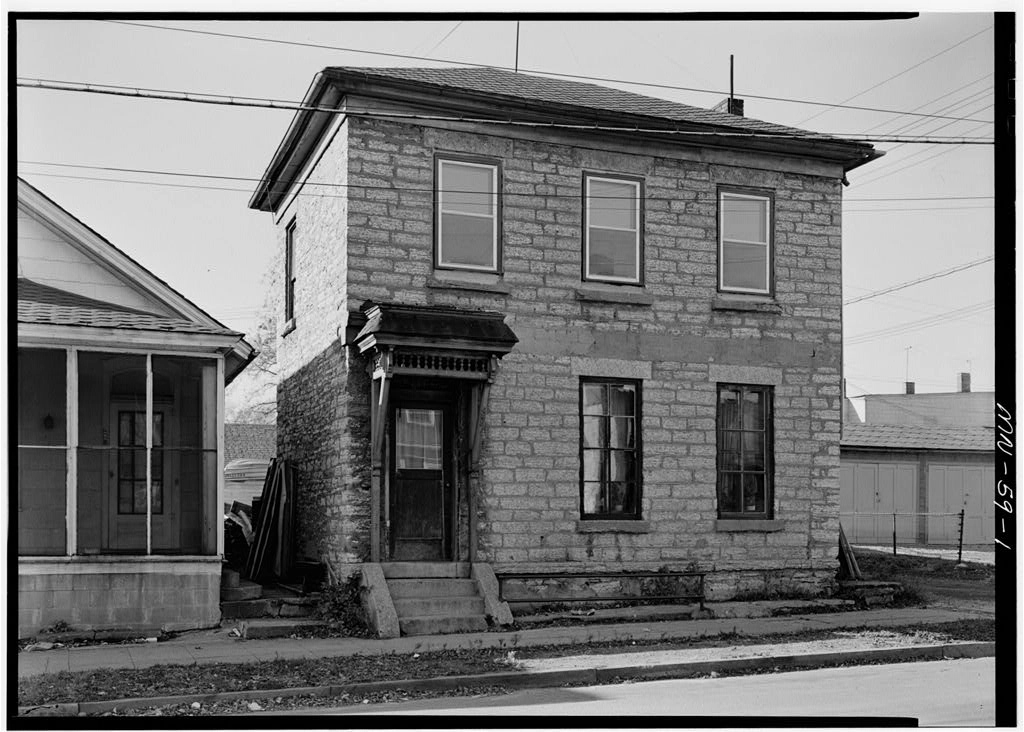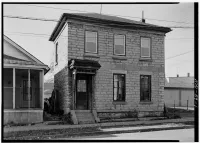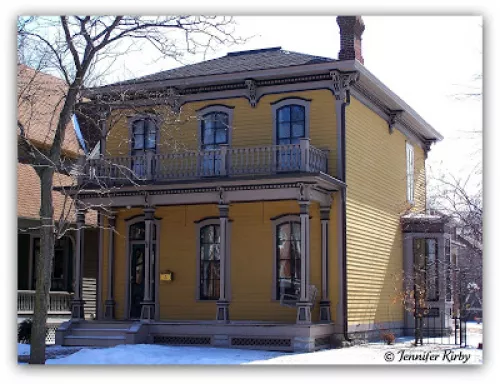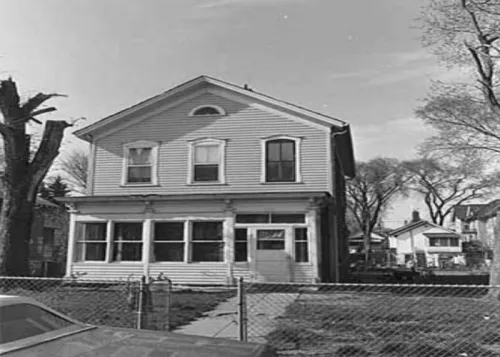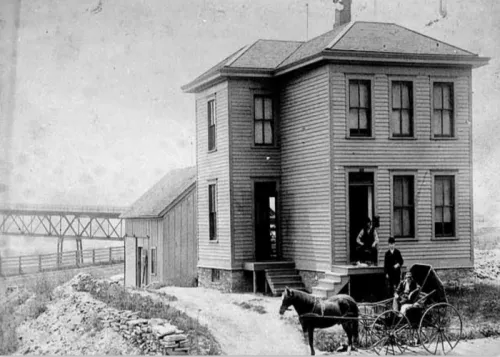Share what you know,
and discover more.
Share what you know,
and discover more.
Jun 22, 2022

-

- Charmaine Bantugan
Waldmann Brewery
Waldmann Brewery By Caroline Daykin with research support from Historic Saint Paul In 1857, six months before Minnesota became a state, German stonemason George Amos built a limestone saloon near St. Paul’s Upper Landing. For the next six years, the saloon served lager beer to the city’s German community. Between stints in the lumber and grain businesses, Bavarian immigrant Anton Waldmann operated the saloon, which is now St. Paul’s oldest surviving commercial building. Despite its commercial history, Waldmann Brewery served as a residence for most of its life before reopening as a brewery in 2017. When the building was renovated several historical elements were incorporated, including virgin pine floors, wood burning stoves, handblown glass windows, and oil lamps atop the tables. In the mid 1800s, these lamps would have been fueled by whale oil, but Waldmann substitutes paraffin. In addition to the building itself, other remnants of history were found throughout the site, including a well and the remains of five outhouses, or privies. In urban areas in the 19th century privies were often placed along an alley behind the buildings they served. In addition to serving as the precursors of modern day bathrooms, privies were also used to dispose of household garbage. At the Waldmann site, the privies contained bottles, dishes, a rare beer token, and a stencil reading “A. Waldmann.” A new, yet historically accurate, outbuilding was added during the renovation. Because the site lacked space to brew beer, a brewery was built to resemble a 19th century urban barn. In the mid-1800s, city dwellers often kept livestock such as pigs and cows, which grazed in common areas within the city. In St. Paul’s early days lager saloons served as a gathering place for the German community. Unlike their counterparts from other European countries, Minnesotans of German descent tended to oppose the temperance movement. While others extolled the virtues of total abstinence from alcohol, the Germans viewed beer as a way to drink in moderation and thus avoid the social problems that accompanied hard liquor. Minnesota laws, including the Lager Beer Act of 1860, also gave preferential treatment to establishments that served only lager beer as opposed to hard liquor. The act exempted breweries and saloons from liquor license fees and taxes. The restoration of Waldmann Brewery brings back to life not only the building's short-lived history as a saloon, but also the wider history of German lager saloons in St. Paul. Cite this Page Caroline Daykin , “Waldmann Brewery,” Saint Paul Historical, accessed June 22, 2022, https://saintpaulhistorical.com/items/show/414.
Waldmann Brewery
Waldmann Brewery By Caroline Daykin with research support from Historic Saint Paul In 1857, six months before Minnesota became a state, German stonemason George Amos built a limestone saloon near St. Paul’s Upper Landing. For the next six years, the saloon served lager beer to the city’s German community. Between stints in the lumber and grain businesses, Bavarian immigrant Anton Waldmann operated the saloon, which is now St. Paul’s oldest surviving commercial building. Despite its commercial history, Waldmann Brewery served as a residence for most of its life before reopening as a brewery in 2017. When the building was renovated several historical elements were incorporated, including virgin pine floors, wood burning stoves, handblown glass windows, and oil lamps atop the tables. In the mid 1800s, these lamps would have been fueled by whale oil, but Waldmann substitutes paraffin. In addition to the building itself, other remnants of history were found throughout the site, including a well and the remains of five outhouses, or privies. In urban areas in the 19th century privies were often placed along an alley behind the buildings they served. In addition to serving as the precursors of modern day bathrooms, privies were also used to dispose of household garbage. At the Waldmann site, the privies contained bottles, dishes, a rare beer token, and a stencil reading “A. Waldmann.” A new, yet historically accurate, outbuilding was added during the renovation. Because the site lacked space to brew beer, a brewery was built to resemble a 19th century urban barn. In the mid-1800s, city dwellers often kept livestock such as pigs and cows, which grazed in common areas within the city. In St. Paul’s early days lager saloons served as a gathering place for the German community. Unlike their counterparts from other European countries, Minnesotans of German descent tended to oppose the temperance movement. While others extolled the virtues of total abstinence from alcohol, the Germans viewed beer as a way to drink in moderation and thus avoid the social problems that accompanied hard liquor. Minnesota laws, including the Lager Beer Act of 1860, also gave preferential treatment to establishments that served only lager beer as opposed to hard liquor. The act exempted breweries and saloons from liquor license fees and taxes. The restoration of Waldmann Brewery brings back to life not only the building's short-lived history as a saloon, but also the wider history of German lager saloons in St. Paul. Cite this Page Caroline Daykin , “Waldmann Brewery,” Saint Paul Historical, accessed June 22, 2022, https://saintpaulhistorical.com/items/show/414.
Jun 22, 2022
Waldmann Brewery
Waldmann BreweryBy Caroline Daykin with research support from Historic Saint Paul
In 1857, six months before Minnesota became a state, German stonemason George Amos built a limestone saloon near St. Paul’s Upper Landing. For the next six years, the saloon served lager beer to the city’s German community. Between stints in the lumber and grain businesses, Bavarian immigrant Anton Waldmann operated the saloon, which is now St. Paul’s oldest surviving commercial building.
Despite its commercial history, Waldmann Brewery served as a residence for most of its life before reopening as a brewery in 2017. When the building was renovated several historical elements were incorporated, including virgin pine floors, wood burning stoves, handblown glass windows, and oil lamps atop the tables. In the mid 1800s, these lamps would have been fueled by whale oil, but Waldmann substitutes paraffin.
In addition to the building itself, other remnants of history were found throughout the site, including a well and the remains of five outhouses, or privies. In urban areas in the 19th century privies were often placed along an alley behind the buildings they served. In addition to serving as the precursors of modern day bathrooms, privies were also used to dispose of household garbage. At the Waldmann site, the privies contained bottles, dishes, a rare beer token, and a stencil reading “A. Waldmann.”
A new, yet historically accurate, outbuilding was added during the renovation. Because the site lacked space to brew beer, a brewery was built to resemble a 19th century urban barn. In the mid-1800s, city dwellers often kept livestock such as pigs and cows, which grazed in common areas within the city.
In St. Paul’s early days lager saloons served as a gathering place for the German community. Unlike their counterparts from other European countries, Minnesotans of German descent tended to oppose the temperance movement. While others extolled the virtues of total abstinence from alcohol, the Germans viewed beer as a way to drink in moderation and thus avoid the social problems that accompanied hard liquor. Minnesota laws, including the Lager Beer Act of 1860, also gave preferential treatment to establishments that served only lager beer as opposed to hard liquor. The act exempted breweries and saloons from liquor license fees and taxes.
The restoration of Waldmann Brewery brings back to life not only the building's short-lived history as a saloon, but also the wider history of German lager saloons in St. Paul.
Cite this Page
Caroline Daykin , “Waldmann Brewery,” Saint Paul Historical, accessed June 22, 2022, https://saintpaulhistorical.com/items/show/414.
Posted Date
Jun 21, 2022
Historical Record Date
Jun 22, 2022
Source Name
Saint Paul Historical
Source Website
Delete Story
Are you sure you want to delete this story?
May 01, 2017
May 01, 2017
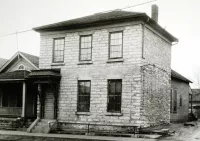
-

- Eric Strand
Waldmann
The building that houses Waldmann was constructed in the fall of 1857 — six months before Minnesota became a state, nearly four years before the American Civil War began, and at a time when less than 10,000 people lived in Saint Paul. It is the oldest surviving commercial building in Saint Paul. Its rich history and distinctive limestone construction merited designation as an official Saint Paul Heritage Preservation Site in 2015. The building isn’t just old — it’s an old lager beer saloon. German lager beer took America by storm in the 1850s. First introduced here in 1848, lager beer became immediately popular with Americans — and frontier Minnesotans — who had never seen any thing like it before. By the time Anton Waldmann’s saloon was built, Saint Paul had twelve breweries, ten of which brewed only lagers. Because Temperance supporters thought lager contained less alcohol (it doesn’t), city ordinances granted favorable treatment to lager saloons. German lager saloons were very special places. Unlike Yankee whisky bars, lager saloons served beer almost exclusively, and frequently offered hearty foods, music, family entertainment, and sometimes even political debates. Women and children were always welcome. Waldmann stays true to these traditions today. Re-opened in 2017 for the first time in 154 years, our building still offers wood stoves, virgin pinewood floors, hand-blown window glass, a large collection of 19th century steamboat chairs, whale oil lamps (burning paraffin), and many period maps, photographs and other memorabilia. And don’t forget to take a selfie with Bismark the Bison upstairs! Prosit.
Waldmann
The building that houses Waldmann was constructed in the fall of 1857 — six months before Minnesota became a state, nearly four years before the American Civil War began, and at a time when less than 10,000 people lived in Saint Paul. It is the oldest surviving commercial building in Saint Paul. Its rich history and distinctive limestone construction merited designation as an official Saint Paul Heritage Preservation Site in 2015. The building isn’t just old — it’s an old lager beer saloon. German lager beer took America by storm in the 1850s. First introduced here in 1848, lager beer became immediately popular with Americans — and frontier Minnesotans — who had never seen any thing like it before. By the time Anton Waldmann’s saloon was built, Saint Paul had twelve breweries, ten of which brewed only lagers. Because Temperance supporters thought lager contained less alcohol (it doesn’t), city ordinances granted favorable treatment to lager saloons. German lager saloons were very special places. Unlike Yankee whisky bars, lager saloons served beer almost exclusively, and frequently offered hearty foods, music, family entertainment, and sometimes even political debates. Women and children were always welcome. Waldmann stays true to these traditions today. Re-opened in 2017 for the first time in 154 years, our building still offers wood stoves, virgin pinewood floors, hand-blown window glass, a large collection of 19th century steamboat chairs, whale oil lamps (burning paraffin), and many period maps, photographs and other memorabilia. And don’t forget to take a selfie with Bismark the Bison upstairs! Prosit.
Waldmann
The building that houses Waldmann was constructed in the fall of 1857 — six months before Minnesota became a state, nearly four years before the American Civil War began, and at a time when less than 10,000 people lived in Saint Paul. It is the oldest surviving commercial building in Saint Paul. Its rich history and distinctive limestone construction merited designation as an official Saint Paul Heritage Preservation Site in 2015.The building isn’t just old — it’s an old lager beer saloon. German lager beer took America by storm in the 1850s. First introduced here in 1848, lager beer became immediately popular with Americans — and frontier Minnesotans — who had never seen any thing like it before. By the time Anton Waldmann’s saloon was built, Saint Paul had twelve breweries, ten of which brewed only lagers. Because Temperance supporters thought lager contained less alcohol (it doesn’t), city ordinances granted favorable treatment to lager saloons.
German lager saloons were very special places. Unlike Yankee whisky bars, lager saloons served beer almost exclusively, and frequently offered hearty foods, music, family entertainment, and sometimes even political debates. Women and children were always welcome.
Waldmann stays true to these traditions today. Re-opened in 2017 for the first time in 154 years, our building still offers wood stoves, virgin pinewood floors, hand-blown window glass, a large collection of 19th century steamboat chairs, whale oil lamps (burning paraffin), and many period maps, photographs and other memorabilia. And don’t forget to take a selfie with Bismark the Bison upstairs! Prosit.
Posted Date
Jun 12, 2022
Historical Record Date
May 01, 2017
Source Name
Waldmann Brewery
Source Website
Delete Story
Are you sure you want to delete this story?
May 01, 1858

-

- Eric Strand
Waldmann
The building that houses Waldmann was constructed in the fall of 1857 — six months before Minnesota became a state, nearly four years before the American Civil War began, and at a time when less than 10,000 people lived in Saint Paul. It is the oldest surviving commercial building in Saint Paul. Its rich history and distinctive limestone construction merited designation as an official Saint Paul Heritage Preservation Site in 2015. The building isn’t just old — it’s an old lager beer saloon. German lager beer took America by storm in the 1850s. First introduced here in 1848, lager beer became immediately popular with Americans — and frontier Minnesotans — who had never seen any thing like it before. By the time Anton Waldmann’s saloon was built, Saint Paul had twelve breweries, ten of which brewed only lagers. Because Temperance supporters thought lager contained less alcohol (it doesn’t), city ordinances granted favorable treatment to lager saloons. German lager saloons were very special places. Unlike Yankee whisky bars, lager saloons served beer almost exclusively, and frequently offered hearty foods, music, family entertainment, and sometimes even political debates. Women and children were always welcome. Waldmann stays true to these traditions today. Re-opened in 2017 for the first time in 154 years, our building still offers wood stoves, virgin pinewood floors, hand-blown window glass, a large collection of 19th century steamboat chairs, whale oil lamps (burning paraffin), and many period maps, photographs and other memorabilia. And don’t forget to take a selfie with Bismark the Bison upstairs! Prosit.
Waldmann
The building that houses Waldmann was constructed in the fall of 1857 — six months before Minnesota became a state, nearly four years before the American Civil War began, and at a time when less than 10,000 people lived in Saint Paul. It is the oldest surviving commercial building in Saint Paul. Its rich history and distinctive limestone construction merited designation as an official Saint Paul Heritage Preservation Site in 2015. The building isn’t just old — it’s an old lager beer saloon. German lager beer took America by storm in the 1850s. First introduced here in 1848, lager beer became immediately popular with Americans — and frontier Minnesotans — who had never seen any thing like it before. By the time Anton Waldmann’s saloon was built, Saint Paul had twelve breweries, ten of which brewed only lagers. Because Temperance supporters thought lager contained less alcohol (it doesn’t), city ordinances granted favorable treatment to lager saloons. German lager saloons were very special places. Unlike Yankee whisky bars, lager saloons served beer almost exclusively, and frequently offered hearty foods, music, family entertainment, and sometimes even political debates. Women and children were always welcome. Waldmann stays true to these traditions today. Re-opened in 2017 for the first time in 154 years, our building still offers wood stoves, virgin pinewood floors, hand-blown window glass, a large collection of 19th century steamboat chairs, whale oil lamps (burning paraffin), and many period maps, photographs and other memorabilia. And don’t forget to take a selfie with Bismark the Bison upstairs! Prosit.
May 01, 1858
Waldmann
The building that houses Waldmann was constructed in the fall of 1857 — six months before Minnesota became a state, nearly four years before the American Civil War began, and at a time when less than 10,000 people lived in Saint Paul. It is the oldest surviving commercial building in Saint Paul. Its rich history and distinctive limestone construction merited designation as an official Saint Paul Heritage Preservation Site in 2015.The building isn’t just old — it’s an old lager beer saloon. German lager beer took America by storm in the 1850s. First introduced here in 1848, lager beer became immediately popular with Americans — and frontier Minnesotans — who had never seen any thing like it before. By the time Anton Waldmann’s saloon was built, Saint Paul had twelve breweries, ten of which brewed only lagers. Because Temperance supporters thought lager contained less alcohol (it doesn’t), city ordinances granted favorable treatment to lager saloons.
German lager saloons were very special places. Unlike Yankee whisky bars, lager saloons served beer almost exclusively, and frequently offered hearty foods, music, family entertainment, and sometimes even political debates. Women and children were always welcome.
Waldmann stays true to these traditions today. Re-opened in 2017 for the first time in 154 years, our building still offers wood stoves, virgin pinewood floors, hand-blown window glass, a large collection of 19th century steamboat chairs, whale oil lamps (burning paraffin), and many period maps, photographs and other memorabilia. And don’t forget to take a selfie with Bismark the Bison upstairs! Prosit.
Posted Date
Jun 12, 2022
Historical Record Date
May 01, 1858
Source Name
Waldmann Brewery
Source Website
Delete Story
Are you sure you want to delete this story?
Anton Waldman House, 445 Smith St Saint Paul, Ramsey County, MN
HABS MN-59Posted Date
Sep 27, 2021
Source Name
Library of Congress
Source Website
Delete Story
Are you sure you want to delete this story?
